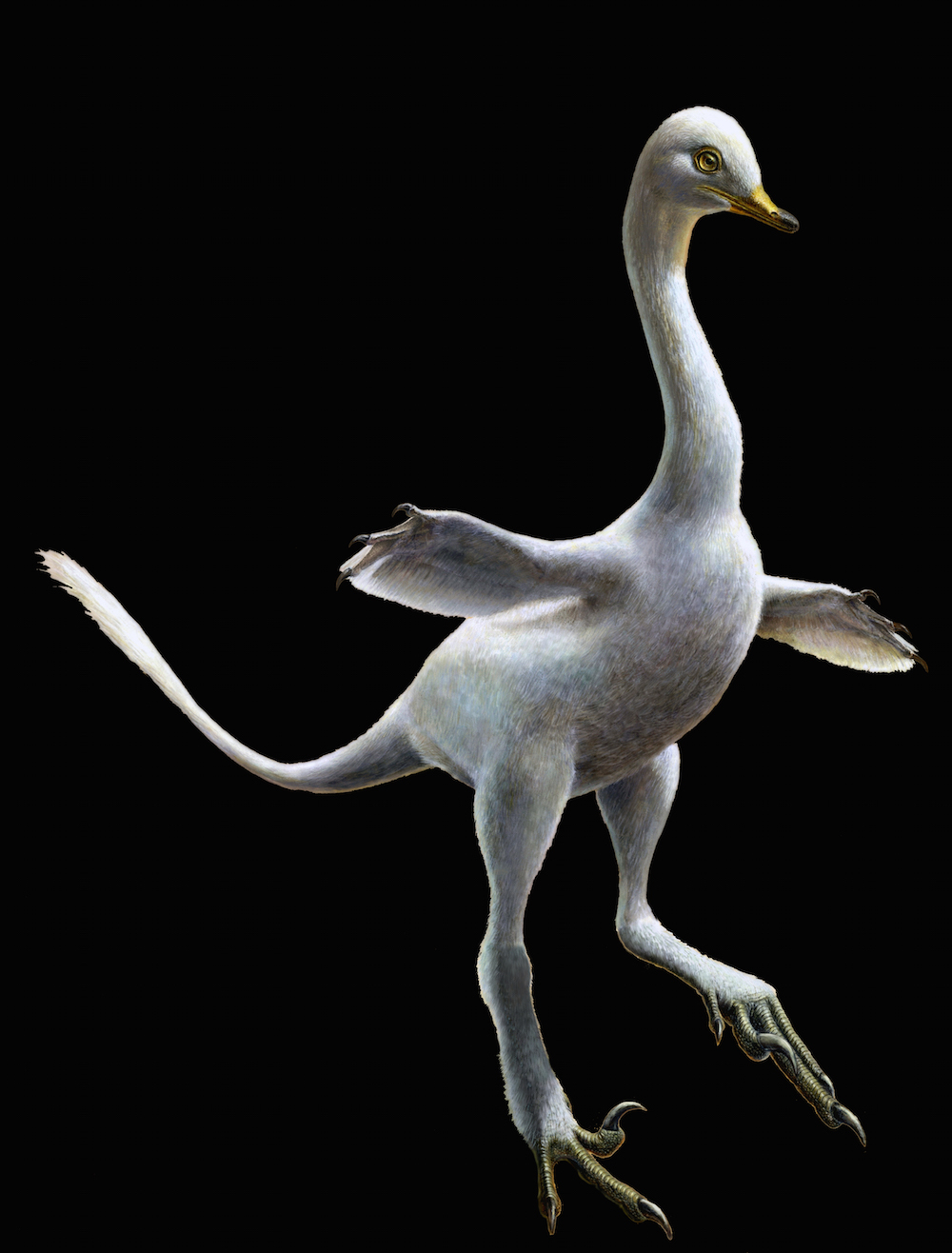This Dinosaur Fossil Was So Bizarre, Scientists Thought It Was Fake

An enigmatic dinosaur — which sported a swan-like neck, amphibious flippers and Velociraptor-esque claws — could walk like a duck and swim like a penguin during its heyday on Earth, scientists have found after examining its fossilized remains.
In fact, the remains, which were on the black market for years, painted such a wacky image of a dinosaur that paleontologists thought it was a sophisticated fake at first. [See images of the swan-necked, amphibious dinosaur]
Its discovery reveals that the bird-like dinosaur was likely semiaquatic and felt right at home in the water, the researchers said. This is surprising because the newfound species is a theropod — a group of bipedal, mostly meat-eating dinosaurs that includes Tyrannosaurus rex — and it's thought that most theropods didn't spend much time in the water, the researchers said. (The major exception being Spinosaurus. Also, T. rex could likely swim, fossilized underwater footprints show.)
The newly identified species likely swam with its flipper-like arms, and its long neck likely helped it with foraging and ambush hunting, the researchers said.
Black market
The newfound dinosaur hails from Ukhaa Tolgod, a dinosaur graveyard in southern Mongolia. Researchers named it Halszkaraptor escuilliei, or "Halszka" for short, honoring Halszka Osmólska (1930-2008), a Polish paleontologist who specialized in Mongolian dinosaurs. The species name honors François Escuillié, who returned the poached specimen to Mongolia, the researchers wrote in the study.
"Illegally exported from Mongolia, Halszka resided in private collections around the world before it was acquired in 2015 and offered to paleontologists for study and to prepare its return to Mongolia," study senior researcher Pascal Godefroit, a paleontologist at the Royal Belgian Institute of Natural Sciences in Brussels, said in a statement.
Once H. escuilliei was safely delivered to scientists, they set about analyzing it. But the bizarre dinosaur didn't fit into any of the predatory dinosaur groups known from Mongolia. Rather, it had a mix of reptilian, avian and amphibian characteristics. It even had sickle-like "killer claws" on its feet, like those of Velociraptor, the researchers noted.
Get the world’s most fascinating discoveries delivered straight to your inbox.
"The first time I examined the specimen, I even questioned whether it was a genuine fossil," study lead researcher Andrea Cau, a paleontologist at the Geological Museum Giovanni Capellini in Bologna, Italy, said in the statement.
Real deal?
To ensure the specimen was real, and not a fake configured on the black market, the researchers analyzed it with synchrotron multi-resolution X-ray microtomography. This technique allowed the researchers to take multiple X-rays that were 100 billion times more powerful than X-rays used in hospitals. The scientists then assembled these X-rays to create a virtual 3D image of the dinosaur.
Much to the scientists' delight, the results showed that the specimen appeared to be a genuine animal, and not a fake specimen pieced together from different fossils, said study co-researcher Dennis Voeten, a researcher at the European Synchrotron Radiation Facility (ESRF).
The synchrotron also revealed that the dinosaur has a number of teeth in its mouth that can't be seen with the naked eye, study co-researcher Vincent Beyrand, a researcher at the ESRF, said. "We also identified a neurovascular mesh inside its snout that resembles those of modern crocodiles to a remarkable degree," Beyrand said in the statement. "These aspects suggest that Halszka was an aquatic predator."
The synchrotron also showed that Halszka walked on two legs while on land, likely with the same posture that modern ducks have. While in the water, the bird-like dinosaur likely used its "flippers" to swim, much like penguins do today, the researchers said. [In Images: Digging Up a Swimming Dinosaur Called Spinosaurus]
Despite its odd features, Halszka isn't the only bizarre dinosaur from the Gobi Desert. Several other strange Mongolian theropods appear to be closely related to it, which prompted the researchers to create Halszkaraptorinae, a new group that is a subfamily of the dromaeosaurs, a dinosaur group commonly known as raptors.
However, some scientists are still skeptical about Halszka's validity.
It could be a weird new type of dinosaur, "but because the specimen was collected by poachers and sold on the black market, I am just not 100 percent sure it hasn't been tampered with," said Steve Brusatte, a paleontologist at the University of Edinburgh. "Some fakes these days are so sophisticated."
The conclusion that the dinosaur was semiaquatic is not a "slam dunk," Brusatte added. "The evidence is mostly circumstantial at this point," he told Live Science in an email. "For instance, the long neck is seen in many other small theropods, and is even seen in modern dinosaurs that are not aquatic, like ostriches."
Despite this uncertainty, "I'm very excited about this fossil, but I think it raises more questions than it answers, and we'll probably be debating about it for years," Brusatte said.
The study was published online yesterday (Dec. 6) in the journal Nature.
Original article on Live Science.

Laura is the managing editor at Live Science. She also runs the archaeology section and the Life's Little Mysteries series. Her work has appeared in The New York Times, Scholastic, Popular Science and Spectrum, a site on autism research. She has won multiple awards from the Society of Professional Journalists and the Washington Newspaper Publishers Association for her reporting at a weekly newspaper near Seattle. Laura holds a bachelor's degree in English literature and psychology from Washington University in St. Louis and a master's degree in science writing from NYU.


